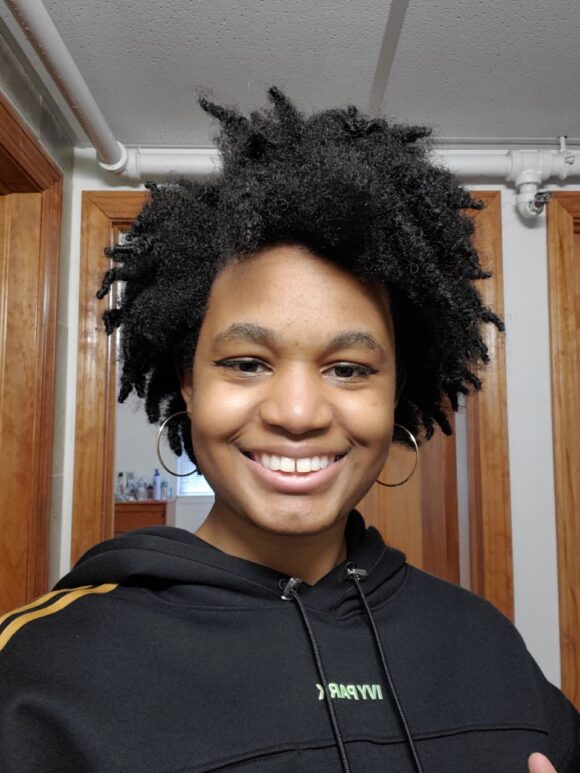
Asia Wright (SEBS’23).
Asia Wright, SEBS’23, Landscape Architecture, won the national Council of Educators in Landscape Architecture (CELA) Fountain Scholar program award, which honors students for past achievements as well as recognizes their future potential to influence the landscape architecture profession.
Now in its 2nd year, the program was established to help Black and Indigenous students of color to advance their landscape architecture education. It recognizes one outstanding student nominated from each landscape architecture program from CELA member institutions. Since 2021 when the program was established, 43 students have been awarded this prestigious national award.
Named for Dr. Charles Fountain, the award supports students of color in landscape architecture “who use their skills and ideas to influence, communicate, lead and advance design solutions for contemporary issues” in alignment with the original goals of Fountain, a former professor and founder of the first accredited landscape architecture program at a Historically Black College or University (HBCU). He was an innovator, educator, and a visionary landscape architect. As one of the first five African-American scholars to earn a professional degree in landscape architecture, he cultivated broad impacts in the field by actively recruiting and mentoring a new generation of African-American designers.
Faculty at the Department of Landscape Architecture (LA) collaborated with SEBS Educational Opportunity Fund (EOF) to help Wright find her passion and develop in the program, and recently spoke with the award winner, who was nominated by LA faculty for her exceptional design skills.
Why did you choose LA as your major?
I began college as a Pre-med Biochemistry major. I wasn’t enjoying the type of work I had to do. I looked at Food Science and Nutritional Sciences but I liked the idea that Landscape Architecture combines art and science. Edrice Wyatt, senior counselor for the SEBS EOF program, had a tour of academic majors, so I came here to look around and got to see a studio presentation, which sold me on the major. That first year I had some time management issues at first because it was such a different type of work. Being at home during the pandemic, I wasn’t getting enough sleep and it was hard to be online. I took things one step at a time. Coming back in person, I think I’ve improved a lot. My skills are paying off now. I’m applying for internships and scholarships.
What do you find most interesting about your major?
Graphic designs, different software and learning to communicate design ideas through drawings. More realistic and more illustrative renders. I graduated early from high school, skipping my junior year, because I took a lot of advanced classes. I was usually quiet. Moved from a primarily white neighborhood to a mostly Hispanic area, so it was hard to adjust to. I took art classes every year. Being creative was important for me.
Tell us about your family
There’s my mom, older brother, younger brother and me. Our family dynamic is private and tight. Sometimes the world is not safe and you don’t always understand strictness until you’re older. I’m closer to my mother now. My brother is a computer science major. My younger brother is hilarious.
Would you like to talk about the Charles Fountain Award?
I applied because I felt qualified now with my work samples. I felt confident. When I saw the deliverables, I realized I could do this. And I appreciated the fact that the award is dedicated to Charles Fountain, one of the first five African-American scholars to earn a professional degree in landscape architecture.
How has SEBS EOF helped you on your Rutgers journey?
They have helped me so much by providing financial and emotional support when times were hard and difficult. They have helped me to get where I am in my life.
What would you want other students and faculty to know about the SEBS EOF program?
EOF is great. It provides support when you need it, and has many opportunities for you to grow in your field through Rutgers research, the Minorities in Agriculture, Natural Resources and Related Sciences (MANRRS) and other programs that they provide.
As a future SEBS EOF alumna, how do you plan to help other EOF students?
I hope as a future EOF alumna, I can help other students by giving guest lectures about handling college life and the right way to go about handling class workload when it gets too difficult.
What career do you envision for yourself?
One of three things—create my own non-profit or work in a firm or for the government. I loved Felicia Davis’ recent common lecture concerning how design work supports the Black diaspora. Thinking also about Elijah Anderson’s lecture about whitespace, I wondered—how can I redefine whitespaces? I wanted to use a different type of drawing to explore this idea—I have been thinking about using animation as a way to redefine whitespaces graphically. It’s important to reconnect African Americans to the land. Lands has always been an issue—we need reconnection to the land and that will help to redefine whitespace.

